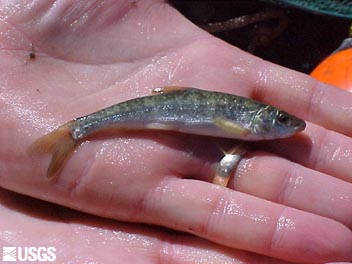- Home
- About S&T
- Taxa/Organisms
- Ecosystems
- Issues
- Methods & Tools
- Reports & Publications
- Location
- Search
 Status & Trends Home
Status & Trends Home  Taxa/Organisms
Taxa/Organisms  Fish
Fish  Freshwater+Fish+Threatened and Endangered Species
Freshwater+Fish+Threatened and Endangered Species
Publisher: USGS | Science Center: Upper Midwest Environmental Sciences Center (UMESC, LaCrosse) | Format: URL
www.umesc.usgs.gov — Paddlefish (Polyodon spathula) have been lost from four states and Canada, and 11 of 22 states within the remaining species range now list the paddlefish as endangered, threatened, or a species of special concern. Restoration of paddlefish populations is a shared goal of many state and federal agencies. UMESC scientists, in collaboration with the More...

Publisher: USGS | Science Center: Western Fisheries Research Center (WFRC, Seattle) | Format: URL
wfrc.usgs.gov — The objectives of this study are 1) to determine how and when juvenile suckers use near-shore habitat with emergent vegetation, 2) determine how the distribution and abundance of juvenile suckers varies between near shore and offshore areas as well as between different areas of the lake over time, 3) determine if water quality conditions affect More...

Publisher: USGS | Science Center: Western Fisheries Research Center (WFRC, Seattle) | Format: URL
wfrc.usgs.gov — Salmonid species in the Pacific Northwest continue to decline despite management efforts to mitigate the effects of development of the Columbia River basin and power system. Altered fish species diversity and changes in the aquatic habitat have created the need for research to determine the status, life history, and habitat requirements of at risk More...

Publisher: USGS | Science Center: Western Fisheries Research Center (WFRC, Seattle) | Format: URL
wfrc.usgs.gov — The objective of this study is to determine the approach pattern and passage locations of juvenile salmonids to assist in planning decisions relative to a behavioral guidance structure at The Dalles Dam. This will be accomplished by comparing estimates of fish, spill and sluiceway passage efficiencies of fish with different approach patterns. The More...

Publisher: USGS | Science Center: Western Fisheries Research Center (WFRC, Seattle) | Format: URL
wfrc.usgs.gov — Bull trout were listed by the U.S. Fish and Wildlife Service as a threatened species throughout the Columbia and Klamath river basins in 1998, and Oregon has listed the North Fork Malheur River population "Of Special Concern". Reasons for the decline of bull trout in the Malheur River likely include habitat degradation, habitat fragmentation, and More...

Publisher: USGS | Science Center: Florida Integrated Science Center (FISC, Gainesville) | Format: URL
fisc.er.usgs.gov — This website provides access to the list of imperiled freshwater and diadromous fishes of North America as determined by the 2008 American Fisheries Society (AFS) Endangered Species Committee (ESC) on Fishes. At this website, one can view lists of imperiled fishes by freshwater ecoregion, by state or province boundary, and plot distributions of More...

Publisher: USGS | Science Center: Fisheries: Aquatic and Endangered Resources | Format: URL
www.usgs.gov — Nearly 40 percent of fish species in North American streams, rivers and lakes are now in jeopardy, according to the most detailed evaluation of the conservation status of freshwater fishes in the last 20 years. The 700 fishes now listed represent a staggering 92 percent increase over the 364 listed as "imperiled" in the previous 1989 study More...

Publisher: USGS | Science Center: Western Fisheries Research Center (WFRC, Seattle) | Format: URL
wfrc.usgs.gov — The goal of this project is to provide vital information on the current status of cutthroat trout (Oncorhynchus clarkii) populations as a necessary prerequisite to determining need and type of future recovery efforts. Coastal cutthroat trout were petitioned for listing under the Endangered Species Act in 1997.

Publisher: USGS | Science Center: Western Fisheries Research Center (WFRC, Seattle) | Format: URL
wfrc.usgs.gov — The Santa Ana sucker (Catostomus santaanae), was recently identified by the U.S. Fish and Wildlife Service (FWS) as a species of special concern. This sucker is endemic to the Los Angeles, San Gabriel, and Santa Ana river drainages of southern California. The purpose of this study was to develop a better understanding of environmental factors More...
